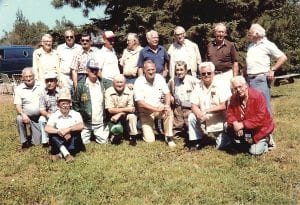The young men who served in the Civilian Conservation Corps (CCC) had a great impact on Cook County—constructing roads, buildings, surveying, installing phone lines, and more. They also made lasting friendships, as is evidenced by this photo of a 1984 reunion at the old CCC campsite in Hovland. Some of the men are unknown—do you know who they are? (L-R, front) 1. Unknown. 2. Ron Ramlo. 3. Walt Matthews (sitting). 4. “Hunk” Anderson. 5. Don Simpson. 6. Fenton Aukeny. 7. Fred Loeding. 8. Ed Luedke. 9. Unknown. (L-R, back) 1. Joe West. 2. Ernie Donkers. 3. Clarence Smiglewski. 4. Unknown. 5. Unknown. 6. Orv Gottlieb. 7. Morrie Quaife. 8. Unknown. 9. Bill Peterson.

The Cook County Historical Society is working on a fascinating exhibit on the Civilian Conservation Corps thanks to a “Legacy” grant awarded by the Minnesota Historical Society. Cook County was significantly impacted by the Depression- Era CCC program. Of the 61 CCC camps authorized for the state of Minnesota, 13 were in the county. At 200 men per company, the area population almost doubled between 1933 and 1935. Many important works were accomplished with this massive influx of labor.
Local men served key leadership roles on projects, guiding the young enrollees in forest conservation, surveying, road work, construction projects, phone line installation and other impressive feats including detailed surveys of 65 area lakes for depth and water quality to determine where to stock fish.
Because so many men remembered the CCC and this area fondly (some even settling here), their family members often visit the museum and have donated many related items to the Historical Society’s collection, especially photographs. As a complement to the museum’s exhibit, over 150 personal photographs showing work and play are being digitized and submitted to the Minnesota Reflections, an online catalog of historic images and documents on the web at www.mndigital. org/reflections.
A replica barracks building will be the centerpiece of the exhibit space to provide a sense of camp life. And oral histories collected in the 1980s by Bill Raff will be entirely transcribed with audio clips featured in the exhibit. Other research materials will also be available on the museum’s web site, www.cookcountyhistory. org, providing the opportunity for researchers everywhere to learn more about this important program and its unique impacts on this region.
If you have any CCC memorabilia, photographs or stories to contribute to the exhibit, please contact the Cook County Historical Society at 387-2883. Official exhibit opening will be summer 2011, but mark your calendars because Dr. James Henderson, author of Lost in the Woods
— The Legacy of CCC Camp Pelican
will be doing a presentation on the history of the CCC program on Aug. 12 at 7 p.m. in the museum’s new community room.


Loading Comments